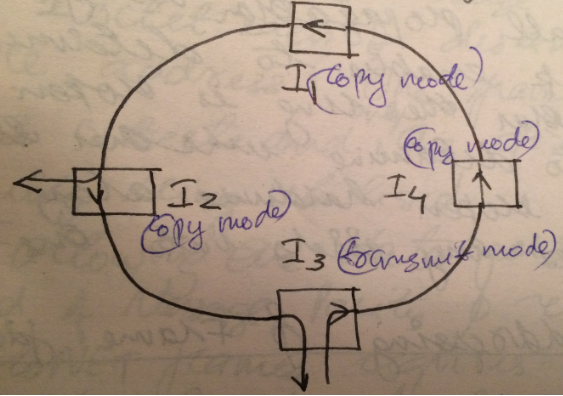ProNET Token Ring Technology
ProNET Token ring technology is an alternative to ethernet technology and it also works fairly good speeds. It uses token ring technology-

Token ring network as shown above consists of hosts connected as a ring via wires that comes out of each host and connected to the other host. Each host in the network engage in token passing and the current host with the token has the right to pass its message frames over the network while the others wait. Once the transmission is complete, the host now passes on the token to another waiting host.
The host in the token ring works in any of the 3 modes – Copy, Transmit or Recovery mode. In the above figure, Interface I3 is in transit mode, sending data to I2. All other interfaces are in copy mode i.e. they reads the bits from the incoming wire and copying them to the outgoing wire and at the same time copying them to local machines memory if the addresses match. I3 operates in transmit mode since it holds the token, transmits the outgoing wire and also verifying correctness by reading it back from the incoming wire.
The small propagation delay of the network enables to determine quickly whether the ring is broken and also to determine whether electrical interference or broken hardware along the path introduces any error into the packet.
ProNET addressing
ProNET interface card doesn’t have a fixed hardware address assigned by the manufacturer, instead is supplied with a set of 8 switches that allows the user to select (28) 256 addresses that are selected and configures using physical switches on the board. Once it is configured, the addresses cannot be quickly or easily changed.
ProNET 10 addresses are much smaller i.e. 8 bits and the hardware addresses of the host machine need not change even of the host interface hardware is replaced. Such a method of addressing has a disadvantage that it leads to address conflicts in the long run.
ProNET frame format

ProNET message frame starts with a 10bit start of message fields followed by 1 octet each of destination and source address. The frame type consists of 3 octets and only first octet is currently being utilized. Following the data portion are the end of message, parity and refuse fields. ProNET frames requires only a single bit for parity checking since it has least propagation delay and hence the sending site receives a copy of the frame during transmission and could easily compare bits in the copy with the succeeding ones to see whether it has changed.
A flag of 7 contiguous 1’s in the user data indicates the end of message. The token and beginning of the message also start with a flag. Whenever 7 contiguous 1’s occur in user data, the hardware modifies the sequence so that the receiver identifies it as data and remodifies it as actual data.
